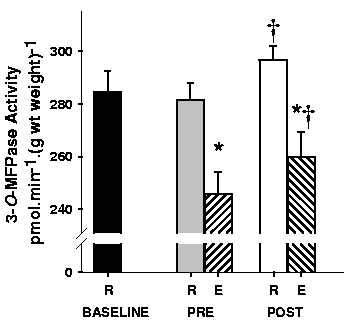Opposing effects of acute and chronic high intensity exercise on Na+K+ATPase activity in skeletal muscle
R.J. Aughey1, K.T. Murphy1, S.A. Clark2, J. Christie2, A.G. Hahn3, C.J. Gore3, A.P. Garnham4, C.M. Chow5, J.A. Hawley2 and M.J. McKenna1, 1Centre for Rehabilitation, Exercise and Sports Science, Victoria University of Technology, Melbourne, 2RMIT University, Melbourne, 3Australian Institute of Sport, Canberra, 4Deakin University, Melbourne and 5University of Sydney, NSW, Australia.
The Na+K+ATPase enzyme is critical
in maintaining muscle trans-sarcolemmal [Na+] and [K+]
gradients and membrane excitability. However, repeated maximal muscle
contractions reduce maximal Na+K+ATPase
activity (Fraser et al., 2002). High-intensity interval training is
commonly used by endurance athletes to improve endurance performance,
but the effects of acute high-intensity interval exercise on muscle
Na+K+ATPase activity are not known.
Furthermore, although sprint training increases muscle Na+K+ATPase
content (McKenna et al., 1993), the effects of high-intensity
interval training on muscle Na+K+ATPase
activity are unknown. We therefore examined the
possible contradictory effects of acute and chronic
high-intensity interval exercise on the muscle
Na+K+ATPase activity in
seven male endurance-trained athletes.
A vastus lateralis muscle
biopsy was taken at rest, 3-wks prior to (Base), at rest and
immediately after exercise prior to (Pre) and after (Post) 3-wks of
training. Muscle samples were analysed for maximal in vitro
Na+K+ATPase (K+
stimulated 3-O-MFPase) activity.
Performance was characterised by incremental
 O2
and
peak power output (PPO); and during a simulated 40km time-trial, by
mean power output (MPO). A t-test was used for
resting 3-O-MFPase activity to
determine reproducibility (Base –
Pre) and to compare change scores (Base–Pre, & Pre-Post) to
identify a change with training. A two-way ANOVA with repeated
measures was applied to test for main effects of exercise (Rest, Ex)
and training (Pre, Post).
O2
and
peak power output (PPO); and during a simulated 40km time-trial, by
mean power output (MPO). A t-test was used for
resting 3-O-MFPase activity to
determine reproducibility (Base –
Pre) and to compare change scores (Base–Pre, & Pre-Post) to
identify a change with training. A two-way ANOVA with repeated
measures was applied to test for main effects of exercise (Rest, Ex)
and training (Pre, Post).

Resting muscle 3-O-MFPase
activity did not differ between Base and Pre.
Acute high-intensity interval exercise
depressed muscle 3-O-MFPase
activity by 12.7±1.2%
(mean±SEM, Exercise main
effect, P<0.05, *,
see figure). In contrast, training
increased 3-O-MFPase activity by
4.9±0.7% (training main
effect, p<0.05, †, see
figure). Resting
3-O-MFPase activity was increased after training by
5.4±1.0% (Pre
– Post change score, P<0.05).
Neither
 O2
(Base 64.4±1.6;
Pre 64.3±1.5;
Post 65.8±1.9),
PPO (Base 368±12;
Pre 374±13;
Post 379±14),
or MPO in the 40km time-trial (Base 279±12;
Pre 303±15;
Post 303±13)
differed significantly after training.
O2
(Base 64.4±1.6;
Pre 64.3±1.5;
Post 65.8±1.9),
PPO (Base 368±12;
Pre 374±13;
Post 379±14),
or MPO in the 40km time-trial (Base 279±12;
Pre 303±15;
Post 303±13)
differed significantly after training.
In conclusion, Na+K+ATPase
measures were reproducible in resting muscle. Acute and chronic
high-intensity interval exercise had converse effects on Na+K+ATPase
activity. The small rise in Na+K+ATPase
activity with training was insufficient to improve exercise
performance.
Fraser, S. F., Li, J. L., Carey, M. F., Wang, X. N.,
Sangkabutra, T., Sostaric, S., Selig, S.E., Kjeldsen, K. &
McKenna, M. J. (2002) Journal of Applied Physiology, 93, 1650-1659.
McKenna, M.J., Schmidt, T.A., Hargreaves, M., Cameron,
L., Skinner, S.L. & Kjeldsen, K. (1993) Journal of Applied
Physiology, 75, 173-180.
This study was partially funded by an Australian
Research Council SPIRT grant (C00002552).
 O2
and
peak power output (PPO); and during a simulated 40km time-trial, by
mean power output (MPO). A t-test was used for
resting 3-O-MFPase activity to
determine reproducibility (Base –
Pre) and to compare change scores (Base–Pre, & Pre-Post) to
identify a change with training. A two-way ANOVA with repeated
measures was applied to test for main effects of exercise (Rest, Ex)
and training (Pre, Post).
O2
and
peak power output (PPO); and during a simulated 40km time-trial, by
mean power output (MPO). A t-test was used for
resting 3-O-MFPase activity to
determine reproducibility (Base –
Pre) and to compare change scores (Base–Pre, & Pre-Post) to
identify a change with training. A two-way ANOVA with repeated
measures was applied to test for main effects of exercise (Rest, Ex)
and training (Pre, Post).
